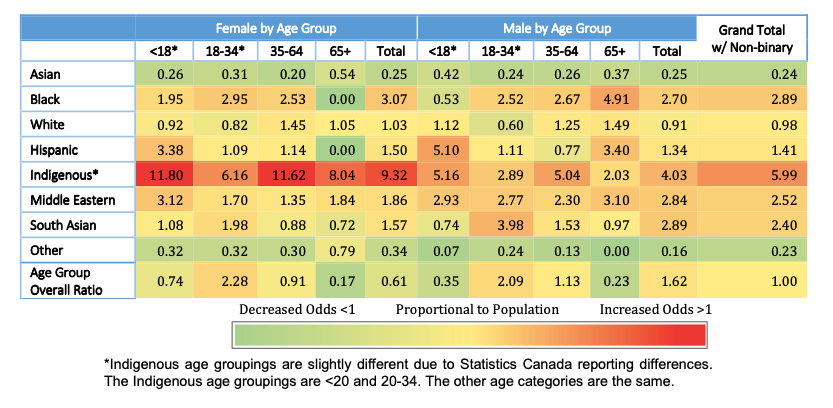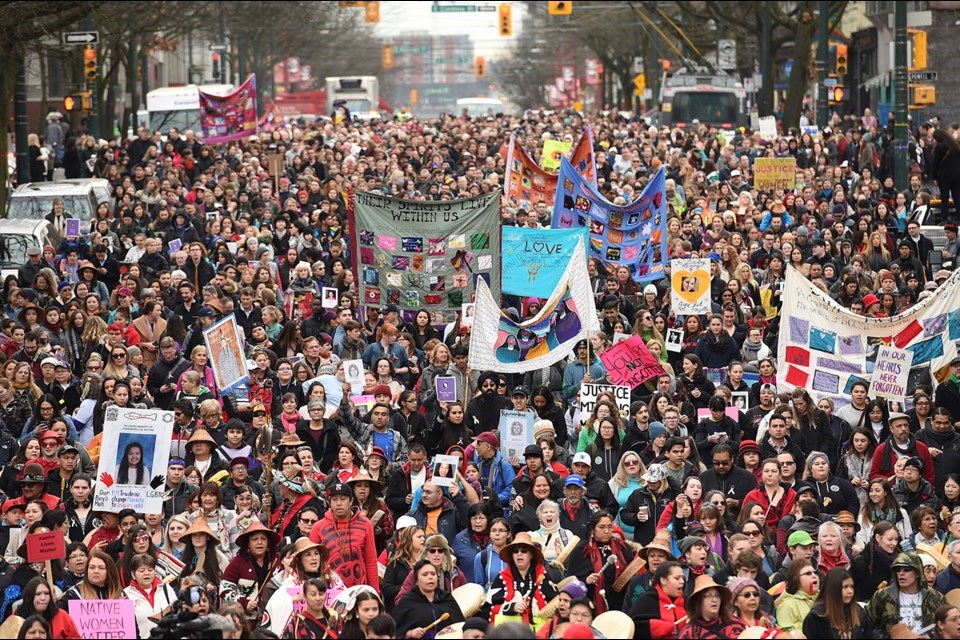Indigenous girls under 18 years old were the most overrepresented victims of violence in Vancouver over the past 12 months, according to new data compiled by the Vancouver Police Department (VPD).
The next two groups of victims based on gender, age and ethnicity were Indigenous women aged 35 to 64 followed by Indigenous women aged 65 and older.
The findings were based on a review of 6,158 victims of violent crimes between April 2022 and March 2023. Assaults, sexual assaults, robberies and homicides were included in determining an “odds ratio score” for victims.
Sgt. Val Spicer said the data helps the department further inform its longstanding programs and initiatives to reduce violent crime in the Indigenous community, particularly among girls and women.
“To actually reduce these numbers, it will take a long time,” Spicer told Glacier Media. “It's not a trend that you can change overnight. It's certainly a trend that you can monitor year to year and see if some of our programming actually impacts certain groupings of individuals.”
The number of Indigenous peoples in Vancouver represent about roughly two per cent of the overall city population, which is estimated at more than 630,000 residents.
The data shows Indigenous girls under 18 were victims of violence 11.80 more times when factoring in population. Indigenous women aged 35 to 64 (11.62) and Indigenous females over 65 (8.04) weren’t far behind.
Indigenous women between 18 and 34 also scored higher (6.16) than any other gender or ethnicity in the same age group, including Black women (2.95), South Asian women (1.98), Middle Eastern women (1.70) and Hispanic women (1.09).
Asian women in all four age categories — from under 18 to over 65 — ranked the lowest, with an average score of 0.25. The average score for all white girls and women was 1.03.

Indigenous boys, men top victims of violence
On the male side, Indigenous boys and men also scored highest when factoring in age and ethnicity, with boys under 18 the victims of violent crime 5.16 more times than others included in the data.
Hispanic boys (5.10), Middle Eastern boys (2.93), white boys (1.12) and Black boys (0.53) rounded out the top-five under-18 category for males. Asian males across all age groups scored lowest at 0.25.
The data was included in a report that went before the Vancouver Police Board April 20. It was the first time police included such level of victim data in a quarterly crime statistics report.
Spicer pointed out the VPD’s programs directed at and involving Indigenous peoples continue to evolve and grow. She mentioned the SisterWatch program, which was established in 2010 with the aim to eliminate violence against girls and women in the Downtown Eastside.
An extension of that initiative is a VPD-led personal safety team that provides regular workshops for women in the Downtown Eastside, where up to 40 per cent of participants are Indigenous females.
The department has an officer dedicated to the Musqueam Indian Band and an Indigenous liaison officer working with the city’s urban Indigenous population. The VPD also has an Indigenous advisory committee and is currently launching a pilot program with the Indigenous community, with details to be released at a later date.
“The more awareness we have around any trends within our data, the better programming we can actually design,” Spicer said of the department’s review of victims of violence.
'Really alarming'
The findings do not come as a surprise to Heiltsuk Nation Chief Marilyn Slett, who is also the secretary-treasurer of the Union of BC Indian Chiefs. Indigenous peoples continue to be overrepresented in homeless counts, drug overdoses and jails, too, Slett said.
Street checks also saw Indigenous peoples at the top of the list.
She pointed to the deteriorating effect colonialism has had on Indigenous people's mental and physical health. First-hand and intergenerational trauma from residential schools, the child welfare system, racism and poverty have all made Indigenous peoples, particularly young women, vulnerable to violence.
“These are systemic issues that really need to be properly resourced in collaboration with Indigenous peoples so we could see a downward trend, instead of these upward trends, which are really alarming,” Slett said.
While police have a responsibility to serve and protect people, Slett said there has to be a community approach to improve the lives of vulnerable Indigenous women, who continue to survive despite their challenges.
“It definitely needs to be a wraparound service approach,” she said. “That includes the police, it includes the Indigenous community and includes health support — and certainly all levels of government working together.”
In 2019, the Vancouver police issued a statement in response to the final report from the national inquiry into Missing and Murdered Indigenous Women and Girls, acknowledging an overhaul was needed in the justice system.
“The VPD recognizes that there are systemic issues within the city, province and country that have resulted in disproportionate police interaction with Indigenous people, and led to increased vulnerability of Indigenous women and girls,” the VPD said at the time.
“Police have a role to play in ending the violence, death and unexplained disappearances of Indigenous women and girls and 2SLGBTQQIA people.”
'Getting access to justice'
Dalya Israel, executive director of Vancouver-based Salal Sexual Violence Support Centre, pointed to the inquiry in providing her response to the VPD’s data on victims of violent crime.
“The [inquiry] points specifically to the need to acknowledge the additional vulnerabilities that Indigenous women and girls and two-spirit people experience in the world — and that they are nine times more likely to experience gender-based violence than any of their counterparts,” Israel said.
“So having that lens is incredibly vital in the Indigenous community getting access to justice.”
For police, she said, the data should again reinforce the seriousness of the overrepresentation of Indigenous girls and women becoming victims of violence. And that if an Indigenous woman goes missing, that no conclusions should be drawn about her past or lifestyle, she said.
“That's a very dominant culture kind of colonizing way of looking at that, without taking into consideration the social context in which colonization has created for Indigenous people,” Israel said. “It’s very dangerous not to apply that social analysis.”
Noelle O'Soup, Tatyanna Harrison, Chelsea Poorman
In recent years, Indigenous females Noelle O’Soup, 14, Tatyanna Harrison, 20, and Chelsea Poorman, 24, all died in mysterious ways. O’Soup’s remains were found in a Downtown Eastside apartment in May 2022.
Around the same time, Harrison’s remains were discovered on a boat in dry dock at a marina in Richmond. Poorman’s remains were discovered in April 2022 in the backyard of a vacant Shaughnessy mansion.
The CBC reported that Harrison died of a “fentanyl toxicity.”
All of their families, including Poorman’s stepfather, Mike Kiernan, have called for more details from police, saying he believes more attention would have been paid to finding his daughter if she weren’t Indigenous.
The VPD has denied the accusation, writing in an email to Glacier Media in July 2022 that “evidence that we have collected so far does not lead us to believe her death was the result of a crime. We are, however, continuing to investigate.”




